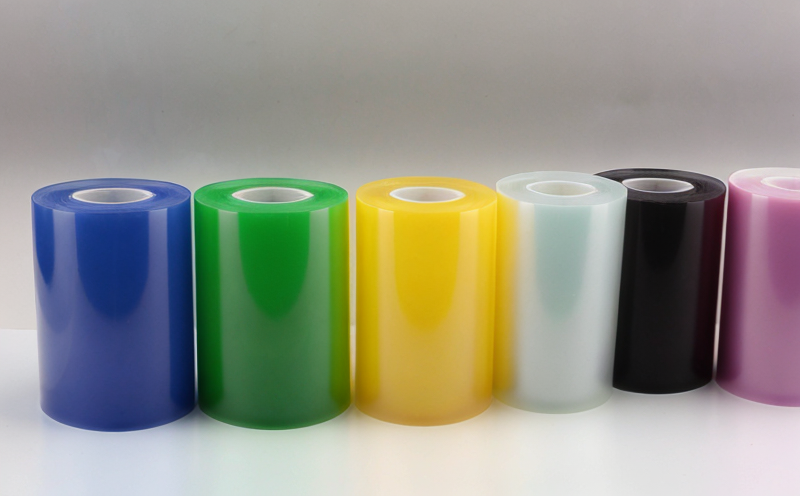BS EN ISO 178 Flexural Properties Testing of Plastic Sheets
The BS EN ISO 178 standard specifies the methods for determining the flexural properties of plastic materials. This test is particularly useful in evaluating the mechanical strength and rigidity of plastic films and sheets, which are widely used in various industries such as packaging, construction, automotive, and electronics.
The flexural modulus (E), flexural yield stress at a given deflection, and ultimate flexural strength are key parameters measured during this test. These properties are critical for understanding the material's behavior under bending loads, which is essential for product design and quality control.
For plastic films and sheets, the test involves preparing specimens with defined dimensions according to the standard requirements. The specimen is then subjected to a flexural load until it yields or breaks. High-quality testing laboratories follow strict procedures to ensure accurate measurements, using precision instruments like universal testing machines calibrated to international standards such as ISO 8578.
The results of this test are typically reported in terms of stress (N/mm2) and strain (%) at various points during the loading cycle. These values help manufacturers and engineers to select materials that meet specific performance requirements, ensuring product reliability and safety.
Understanding the flexural properties of plastic sheets is crucial for applications where rigidity and resistance to deformation are important factors. For instance, in packaging design, selecting a material with adequate flexural strength can enhance the durability and shelf life of the package. In automotive parts manufacturing, this test ensures that components like bumpers and dashboards meet stringent safety standards.
Accurate testing is essential for compliance with international regulations and industry best practices. By adhering to BS EN ISO 178, laboratories ensure that their test results are comparable and reliable across different regions and industries.
In summary, the BS EN ISO 178 flexural properties testing of plastic sheets is a vital tool in quality assurance and product development. It provides critical insights into material performance under bending loads, ensuring that products meet design specifications and regulatory requirements.
Why Choose This Test
The BS EN ISO 178 flexural properties test is an essential tool for manufacturers and quality control professionals who need to ensure the mechanical integrity of plastic films and sheets. By choosing this test, organizations can:
- Evaluate the rigidity and resistance to deformation of plastic materials.
- Ensure compliance with international standards and industry best practices.
- Obtain reliable and accurate data for product development and quality assurance.
- Select materials that meet specific performance requirements.
- Avoid costly failures in end products due to material weaknesses.
The test is particularly beneficial for organizations involved in industries such as packaging, construction, automotive, and electronics. By investing in this testing service, businesses can enhance the reliability and safety of their products, ultimately leading to increased customer satisfaction and market competitiveness.
Customer Impact and Satisfaction
The BS EN ISO 178 flexural properties test plays a crucial role in enhancing product quality and customer satisfaction. By ensuring that plastic films and sheets meet the required mechanical properties, manufacturers can:
- Deliver products that are durable and reliable.
- Avoid product failures due to material weaknesses.
- Maintain consistent performance across production batches.
- Meet regulatory and industry standards, thereby gaining consumer trust.
In the packaging sector, for example, selecting a plastic film with adequate flexural strength ensures that packages remain intact during transportation and storage. In automotive manufacturing, this test helps ensure that parts like bumpers and dashboards can withstand rigorous testing without breaking or deforming.
By investing in high-quality testing services, businesses not only enhance product performance but also improve their reputation and market position. This, in turn, leads to increased customer satisfaction and loyalty.
International Acceptance and Recognition
The BS EN ISO 178 flexural properties test is widely recognized and accepted across the globe due to its strict adherence to international standards. This standard ensures that test results are consistent, reliable, and comparable regardless of location or industry.
Organizations that use this test can:
- Ensure their products meet global regulatory requirements.
- Gain access to international markets without the need for additional testing.
- Avoid costly rejections due to non-compliance with local standards.
The widespread acceptance of this standard also promotes collaboration and knowledge sharing among industries. By using a globally recognized method, businesses can leverage best practices from around the world, ensuring that their products are at the forefront of innovation and quality.
Moreover, compliance with international standards enhances an organization's reputation and credibility, making it easier to attract customers and partners who value high-quality products and services.





